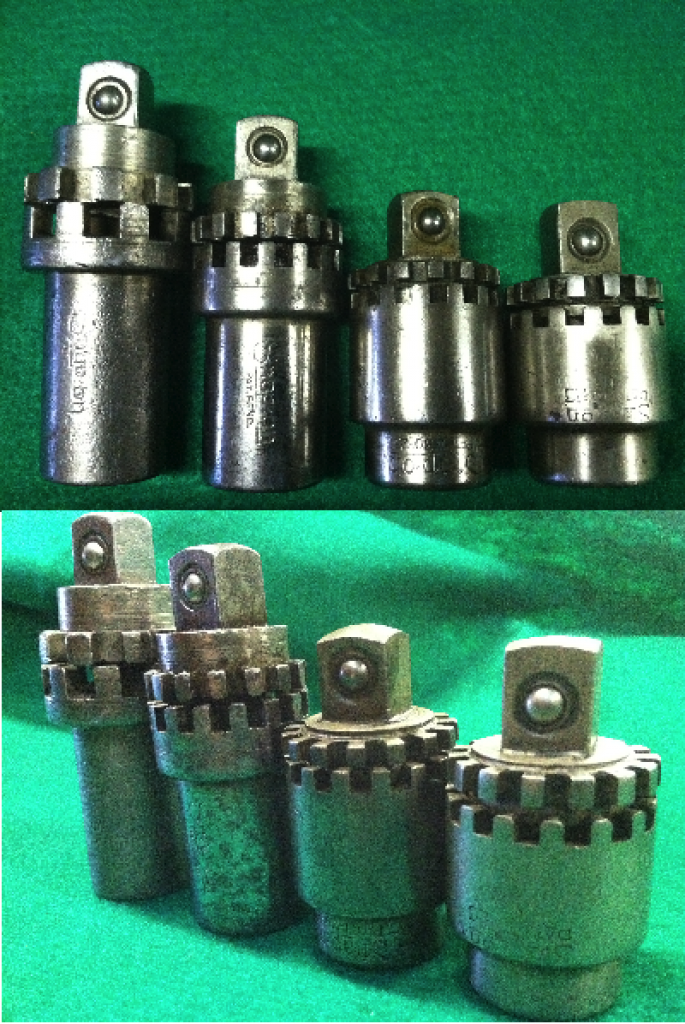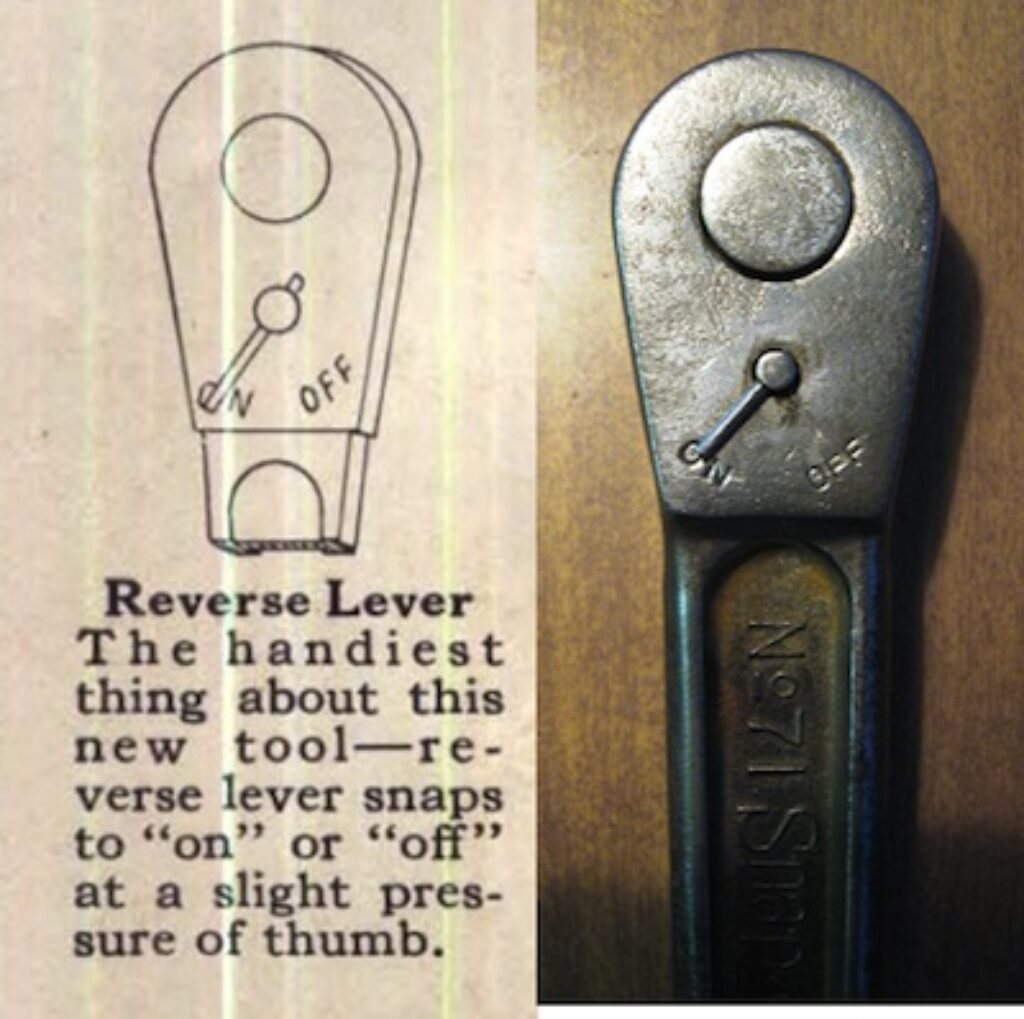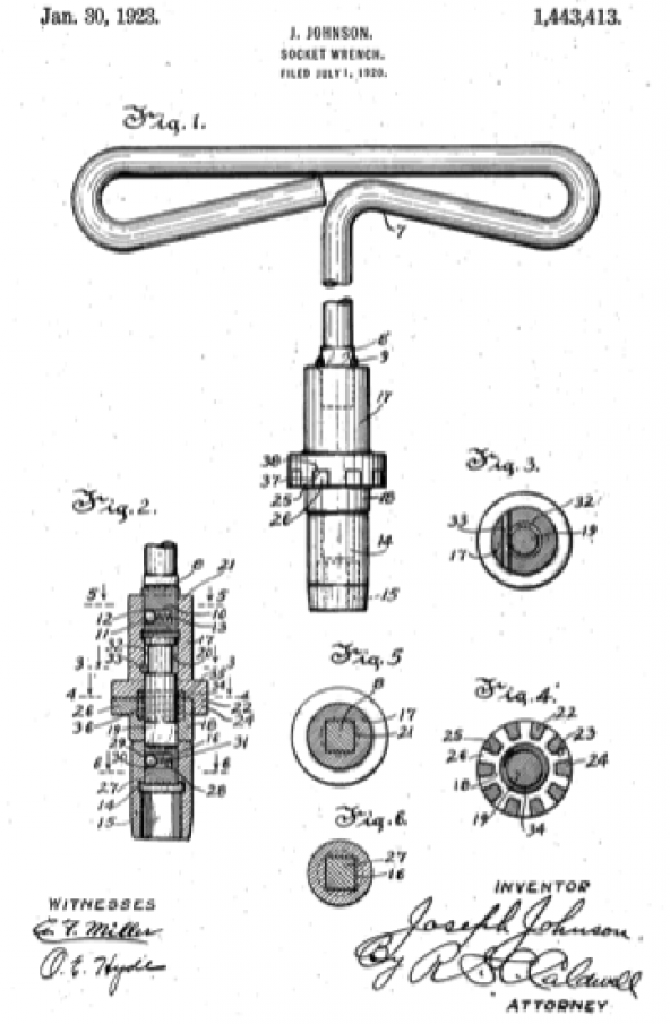1/2 No 6 Ratchet Adaptor - 1920-1929/30
The No 6 Ratchet is easily the most interesting and innovative piece of obsolete technology. This is a speed device that allows any handle to be made into a ratchet handle. The handle and socket are not engaged, held apart by a spring, and will slip until the handle is pressed down. When collapsed, the teeth engage and torque can be applied in either direction. It is a clever and a very short-lived device. These are sometimes called Cogs, Barrel adaptors, Clutch Adaptors and by the proper name: the No 6 Ratchet Adaptor.
There are 4 known versions of No 6 Ratchet Adaptors. There are also stamping variations.
Co- founder of The Snap on Wrench Company, Joe Johnson, filed a patent in July 1920. The patent issued on January 30, 1923. The patent itself gives us a small glimpse into the time and Joe Johnson. Snap On Patent
The first version ran from 1920 to 1922 or early 1923. The device and the patent drawing are very similar. See the Patent. The photo shows “Snap on” and PAT PEND stamped into the ratchet adaptor. The 1923 catalogs shows the third version, but the first and second versions obviously exist! These first and second versions existed prior to the publication of Catalog A. Version one has 9 teeth on the top and bottom (18 total for a one tooth turn of 40 degrees). It is 3 and half inches long and a 1 and a 5/8 inch in maximum diameter – big.


The second version retains the same design, but in a reduced size. It is stamped “Snap on” with a second unreadable line – probably PAT PEND. The second version has more teeth: 15 teeth on the top and bottom (30 total for a one tooth turn of 24 degrees). This is an improvement allowing the user to work in tighter spaces. The spring action is better and requires less force to engage. Version two is also pre 1923. It lasted only a few months. These are rare. It is 2 and 7/8 inches long and a 1 and a 1/8 inch in maximum diameter – Smaller than the first version.
The third version retains the ‘30 tooth’ design of the second version. The third version is still shorter. It retains the quick spring action seen is the second version. Version 3 is the most common version. Shown in the 1923 catalog it ran through 1929 or 1930. Missing from the 1931 catalog and not replaced by a new design until 1939. A similar device is still available as the No 67 Ratchet Adaptor. This third version is 2 and 3/8 inches long and the same 1 and a 1/8 inch in maximum diameter – This is the longest running design.
In the third version there seem to be variations in the stampings. The patent was issued in 1923. I have looked at 8 of these that I own. 7 are stamped Snap on and under neither PAT.1-30-23. One has the 2nd line missing (stamped before the patent issued? Or just a mistake?) Also, one is stamped upside down.
In the fourth version there is a short run fourth version that is rare and even shorter. The size may be difficult to see but these seem to be stamped in the barrel.
There is an additional mythical design rumored to exist.
A 12 tooth version advertised in April in 1922, but never found, it may be the 15 tooth version 2 filled the need and perhaps the 12 tooth version was never produced? Or it is very rare. The copy of the advertisement is Courtesy of Ken Johnson. There is a 2nd advertisement in July 1922 showing the 15 per side – 30 teeth for both. So the 15 teeth exited after July 1922. The 9-tooth version (1) exited before July 1922.
Number | Description | Date Range |
No 6 Version 1 | The largest and most course of the series of “Ratchet Adapters” | 1920-1922 |
No 6 Version 2 | A very short lived version, likely lasted a few months | July1922-23 |
No 6 Version 3 | The most common “Ratchet Adapter” | 1923-1929 |
No 6 Version 4 | Shortest “Ratchet Adapter” | 1929 |
